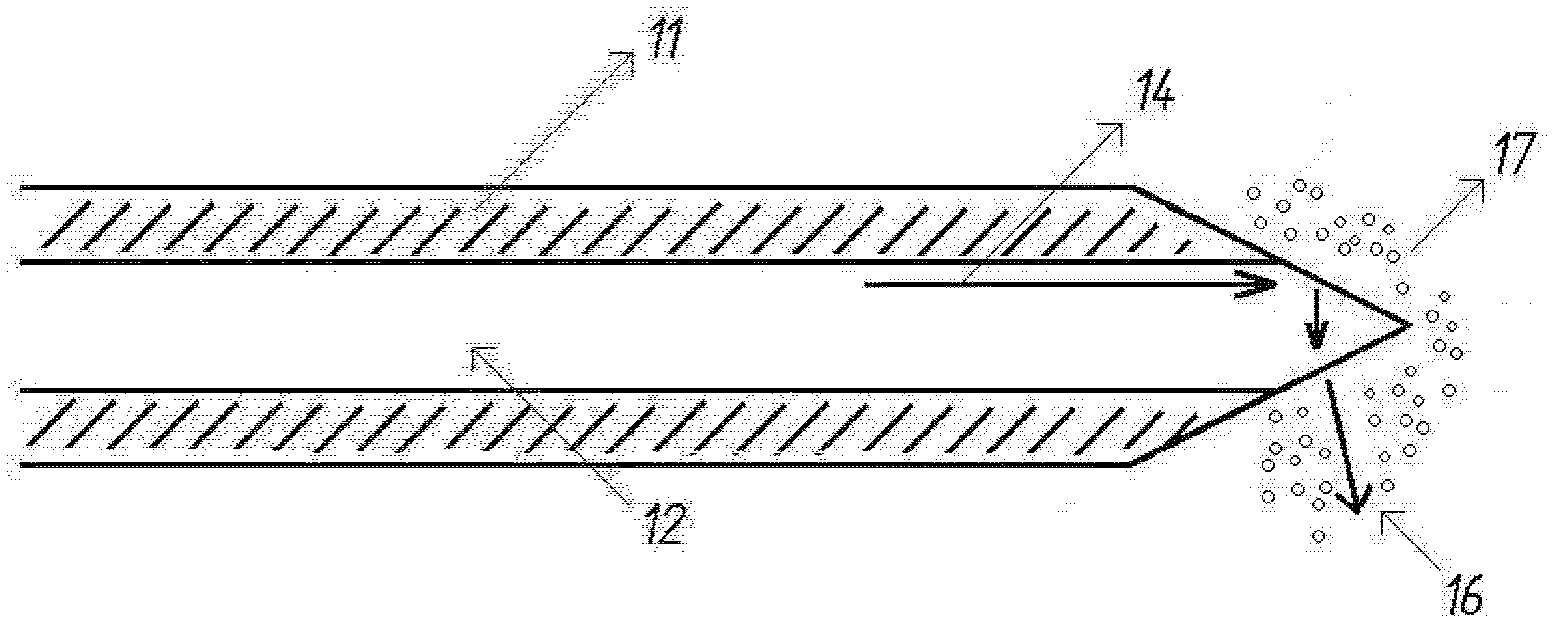Medical laser treatment device and method utilizing total reflection induced by radiation
A technology of optical radiation and laser radiation, applied in the field of laser systems, can solve problems such as large probe diameter, reduced bonding between end cap and glass optical fiber, and bulky optical fiber probe
- Summary
- Abstract
- Description
- Claims
- Application Information
AI Technical Summary
Problems solved by technology
Method used
Image
Examples
example 1
[0026] Example 1 - Glass Fiber with Conical Fiber Tip
[0027] Figure 1a and 1b A preferred embodiment is schematically depicted comprising a glass optical fiber having a refractive index n1 The fiber core (12) and the refractive index n 2 Fiber cladding (11), where n 2 less than n 1 . The optical fiber distal tip (13) has a conical shape.
[0028] When such a probe is surrounded by an aqueous solution (for example, in a vessel supplied with blood), the majority of the optical radiation (14) transmitted inside the fiber core will propagate through the conical fiber tip and as Figure 1a Emitted in the forward direction (15) as shown in .
[0029] Such as Figure 1b As depicted in , the optical power emitted in the forward direction is absorbed by the surrounding liquid medium, which evaporates and thus forms vapor bubbles (17 ). Since the refractive index of water vapor is significantly lower than that of liquid water, the refractive index gradient between the fiber ma...
example 2
[0031] Example 2 - Glass Fiber with Bent Fiber Tip
[0032] Figure 2a and 2b Schematically depicts a preferred embodiment comprising a glass optical fiber having a refractive index n 1 The fiber core (22) and the refractive index n 2 Fiber cladding (21), where n 2 less than n 1 . The fiber tip is bent laterally to deviate from the long axis of the fiber axis. The fiber axis (28) forms an angle α with the normal (29) to the end face of the light. Usually, the value of α is about 20-35°.
[0033] Figure 2a The majority of the illustrated optical power (25) travels in the forward direction.
example 3
[0034] Example 3 - Optical fiber with beveled tip
[0035] Another preferred embodiment is a fiber with a beveled fiber tip, such as Figure 3a and Figure 3b shown in . Laser radiation (34) propagates through the fiber core (32) by means of total internal reflection at the core / cladding interface where the fiber cladding (31) has a higher refractive index (n 1 ) low refractive index n 2 .
[0036] Since the refractive index of the surrounding aqueous solution is lower than n 1 But greater than the refractive index of air or even water vapor, so the laser light is emitted through the beveled head (33) in a straight-ahead direction (35). Once the laser radiation (35) evaporates a specified amount of aqueous solution and creates vapor bubbles (37), the refractive index gradient between the fiber core and its surroundings is changed. The refractive index of the evaporated aqueous solution (37) is low enough that near total reflection occurs at the core / vapor interface. Thu...
PUM
 Login to View More
Login to View More Abstract
Description
Claims
Application Information
 Login to View More
Login to View More - R&D
- Intellectual Property
- Life Sciences
- Materials
- Tech Scout
- Unparalleled Data Quality
- Higher Quality Content
- 60% Fewer Hallucinations
Browse by: Latest US Patents, China's latest patents, Technical Efficacy Thesaurus, Application Domain, Technology Topic, Popular Technical Reports.
© 2025 PatSnap. All rights reserved.Legal|Privacy policy|Modern Slavery Act Transparency Statement|Sitemap|About US| Contact US: help@patsnap.com



